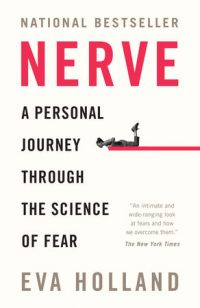
Nerve: A Personal Journey Through the Science of Fear by Eva Holland
Reviewed in Quill & Quire
March 2020
Published by Allen Lane Canada
What makes us afraid? People are generally aware of the well-studied “fight or flight” response that has helped ensure human survival in the face of imminent danger, but what about so-called irrational fears to things like spiders, heights, or – especially – clowns?
In her debut book, Whitehorse journalist and editor Eva Holland sets out to explore the phenomenon of fear by confronting her own (heights, falling, driving, and the fallout from her mother’s death foremost among them) and attempting to gain some control over them through a process of research, therapy, and experiments with eye movement desensitization and reprocessing (EMDR) and exposure treatments.
Fear, Holland tells us, has played an outsized role in her life. As a young child, she never ran to her full potential on the playground because she worried about falling and getting hurt; in adulthood, she found herself huddled against a wall on the narrow upper level of the Duomo in Florence after becoming convinced that if she stood close to the roof’s edge, she would fall through the flimsy barrier, slip across the red tiles, and plummet to her demise.
In her quest to tame her fear, Holland delves into research on various causes and treatment methods and seeks out scientists in the U.S. and Europe who are conducting experiments in the field. (Perplexingly, despite her fear of heights, she has no fear of flying.) However, the book is first and foremost a memoir, and while Holland ensures she gives the science its due, most of it is framed in relation to her desire to be able to go rock climbing with her friends without ending up a sobbing mess.
The work began as a feature in Esquire magazine, and the book reads very much like an extended piece of long-form personal journalism, though it lacks the crispness and snap of the original magazine piece. Still, Holland’s narration is friendly and easygoing, and she is wryly self-observant, noting after her third serious car accident in three years (and fourth since she was a teen) that one might suspect she was just a bad driver. The humour is generally self-deprecating and mild, though there are a couple of laugh-out-loud moments to balance the more sombre aspects of Holland’s story (such as the death of her mother, which turns out to be the catalyst for many of the author’s strongest fear-induced reactions).
What really makes the book is Holland’s cinematic scene setting. Her ability to vividly recall details illuminates every scrape with death, heart-wrenching episode of fear-induced panic, and instance of Holland avoiding danger by trusting her gut. The result makes for an enjoyable read. When, at the end of her journey, she finds herself able to zip line over large, deep gorges and drive in the winter without feeling like her chest is about to explode, we can’t help but cheer.

